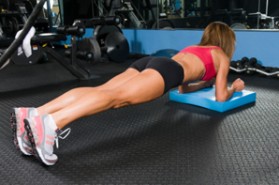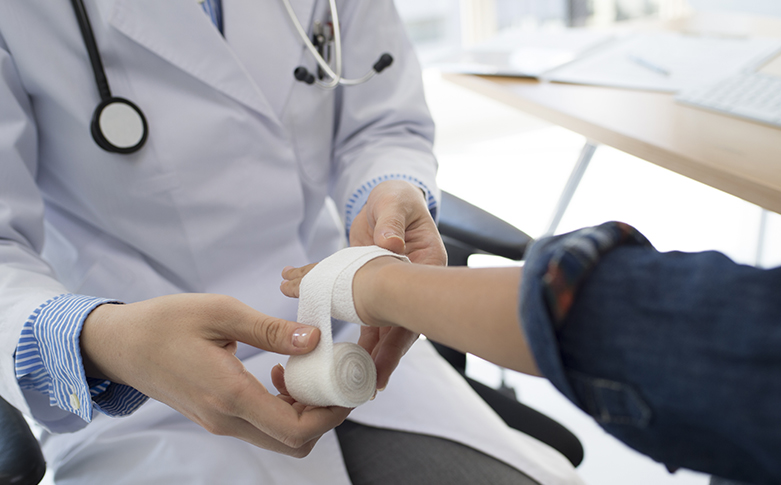Core = the central part of something. And strength in your core is essential; weakness can lead to acute and chronic injuries as well as wear and tear on your joints and ligaments.
Wait a minute—I said your back, and I’m now talking about your core? Most people equate the “core” with the “abdominal area.” They’re right, but there’s a lot more to the definition. Your core is everything and anything that contributes to the stability and safety of your spine. While your abs surely are part of that equation, they’re not the only ingredient. Your core consists of all the musculature and ligaments that hold your pelvis girdle together—front AND back.
So a strong core = a healthy core. And a healthy core = a healthy back. So let’s talk about strengthening your core. Just like flexibility exercises, strengthening exercises are too numerous to count—so I’ll stick to the basics here. These are exercises you can do at home or the gym, and they will have a tremendous impact on your core and your back. Take it from me and my personal experience—if you have a “bad back,” or chronic back pain, “tightening” your core will solve many of your woes.
1. Vacuum
This used to be called “sucking it in”—it just takes a little more effort than simply sucking in your belly. You want to imagine pulling your belly button to your spine using your abdominal muscles. Every muscle from your rib cage down to your waistline is going to retract in unison. Tightening your abs is not enough. Tightening only activates a fraction of your core muscles. You want to imagine your entire core being “vacuumed” and retracted. A deep inspiration or expiration breath will work, but most people like to hold their breath while doing this exercise.
2. Plank (or Bridge)
This exercise is THE gold standard for strengthening your core. The starting position is lying flat on your stomach. You raise your body into the push-up position, except you won’t be on your hands. Your upper body will be supported with you on your elbows. The concept is to keep your entire body level and straight. Most beginners have a tendency to raise their butt high in the air—but the abdomen should be as close to the floor as possible. Raise your torso off the floor and hold this position for as long as you can. The goal is to hold the position for 60 seconds at the very least.
3. Side Plank (or Bridge)
Same instructions as the plank, except now you’re lying on your side. Your upper body is supported on one elbow, and your lower body has your bottom foot lying on its side. You raise your body up into the straight position, making sure not to raise your waist higher than the rest of your body. You will support your entire body on the one elbow. Your upper arm/hand/wrist can simply be at your side. Once again, you will hold this position as long as you can—the goal being at least 60 seconds.
Yes, this is as basic as it gets. Nothing fancy, no complex moves, no need for equipment or exercise bands or weights. Just you, your body and good ol’ gravity. You will be amazed at how difficult holding your unsupported body in the air really is.
Please keep in mind these exercises are to help strengthen your body’s foundation and maintain a healthy back—I DID NOT say these exercises will give you those “six-pack abs” or that slender waistline you may desperately want. You’ll need to maintain a lifestyle of healthful eating combined with a challenging exercise program to get those types of results.
Finally, time for your posture.
Those infamous admonishments to “stand up straight” or “sit up straight” actually bear a lot of weight when it comes to back health. Bad and improper posture can produce muscle and ligament misalignment that can lead to an awful list of acute and chronic back problems. Not only can improper posture hurt your back, but it can affect your overall health in a myriad of ways.
Posture is present in everything you do during the function of your day. That heavy purse you always carry over the right shoulder? It’s affecting your posture. And while most understand proper posture for sitting and standing, posture plays an important role in just about every movement you make.
Here are 4 tips and tricks, small and large, immediate and long-term, that can improve your posture and save your back.
1. Stay Centered
How do you stand still? Do you lean to one side? Do you hike or stick out one hip more than the other? What do you think your leaning is doing to your posture?
Evenly distributing your weight not only takes the stress off the joint in question, it is actually an easier effort to stand centered instead of off to one side. Think about how uneasy one side of your body will start to feel if you stay ‘leaning’ too long.
Is your back straight or are you hunched over? Take stock of how you sit. Be sure to stand tall and sit tall – no slouching!
We all have the tendency to lean forward due to the natural curvature of our spine. It’s an ‘easier’ muscular effort. The slouch is similar to the lean just in a different plane. Sit and stand centered. This means pulling your shoulders back and pushing your chest forward. As you do this, you are ‘forced’ into using and tightening your core. All of this helps stabilize your center of gravity.
2. Carry on, I say
Do you carry a book bag? How about a purse? Maybe a gym bag? Do you carry that bag over the same shoulder EVERY time? Why? Switch it up!
It’s subconscious and all about comfort – but in the end it’s a long term nightmare. Same rules apply – evenly distribute your body weight and any additional weight you are carrying. No need to magnify the imbalance by adding weight, right?
What do you think is happening to your posture by never utilizing both shoulders? Try and use that backpack the way it was intended – over your back, not over a shoulder.
3. Walk this way
Are you wearing flat-soled shoes? How about heeled shoes? Do you have flat feet? Do your feet ache after a long shift?
Do your feet have any support from the shoes you wear? Why not?
All these questions lead to an anatomical evaluation of the bottom of your feet. High arch, low arch or no arch – it doesn’t matter what type of foot you have. What matters is you support them properly. If your feet are ‘sore’ consistently you need to evaluate and reevaluate your foot and the shoe you are wearing (maybe even seek professional assistance in the form of a podiatrist or a physical therapist). The shoe should be firm and form fitting, but comfortable on your toes. High heels and ‘slider’ shoes are recipes for disaster both short and long term.
What happens when a structure doesn’t have a strong and supported base? What do you think is happening to your posture with unsupported shoe wear?
4. You lift me up
Do you have proper lifting technique when lifting heavy objects? How about picking up light objects? What about boosting patients up in bed?
A stable center of gravity includes a widened base. Your feet should be shoulder width apart. Lift with your center of gravity, avoid shifting across it. Don’t lean forward or twist at the waist when lifting. Bend your knees and hips and lift with your legs, not your back. Center your self when lifting. Turn your body as one unit, not just twisting at the waist. Use the buddy system when lifting heavy objects.
It’s the small things that count. The more you ‘pay attention’ to your posture the better your posture will become. Imagine looking at yourself during all these activities. Carry yourself like a well-postured nurse and it won’t be long before you feel like one.
——————-
Safety at work is paramount in our job—not only for our patients, but for ourselves as well! In order to give the very best care to our patients, we should take the very best care of ourselves. So, I’ll repeat myself: Who’s got your back? I mean literally. Who’s taking care of your back?!
This article is mentioned in the Spring 2010 print edition of Scrubs Magazine, which can be found at uniform retail stores nationwide or purchased online. Go to https://medmagazine.com/magazine for a peek inside and to find out where you can get your copy!



















